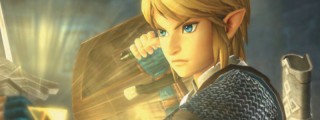This past weekend I managed to get lost in the world of a Samurai. A single warrior walking across a battlefield of a hundred corpses in the name of duty and honor, always in search of glory or a good death. A good samurai film, such as the Kurosawa’s Seven Samurai or Takashi Miike’s 13 Assassins tend to get you lost in a nihilistic yet heroic tale of a few unlucky individuals staring down impossible odds. Despite usually being outmatched these samurai and ronin tend to take a good number of their opposition, making heads roll. Though violence doesn’t always make a samurai film, a good samurai game often tries to capture the feel of being a singular warrior, a wandering ronin, out to create a rain of crimson from the swath of bodies they take. Games such as Onimusha and Way of the Warrior, even the newly released For Honor, make the player the embodiment of honor’s righteous fury.

Cue William Adams, an English, I mean, Irish samurai with a nubile mermaid spirit named Saorise that acts as his friendly companion and guide. The two have been inseparable since childhood, but a vicious alchemist named Edward Kelley kidnaps Saorise so he can find precious magical energy named ‘amrita’ in the name of Queen Elizabeth. Making use of other animalistic Guardian Spirits William sails to Japan, where his companions such as Hattori Hanzo, Tachibana Ginchyo and African-descended samurai Yasuke pair up with William, renamed An’jin in the East, to try and stop Edward Kelley from unleashing a demon plague on Japan. Yeah, the story doesn’t make much sense, each of those is a real historical figure placed in complete scenarios of absurdity. Now while the story isn’t good it takes myth and mirth from Japanese folklore and spiritualism to apply its own uniquely compelling world. Think of what Bloodborne brought to the Dark Souls formula with its Victorian setting. Besides you’re not here for the tale. You’re here to be a badass samurai.
At first glance ‘Soulslike’ is the most apt, perhaps only term to apply to Nioh. Aside from some slight changes Nioh’s HUD looks exactly like the Dark Souls franchise. The tutorial level is exclusively designed to display just how punishing the game is. Shrines serve as save points and a port to juggle William’s skills, similar to Dark Souls’ bonfires. Levels have large looping paths that link back to said shrines via shortcuts. Your goal is to loot up, pump your relevant stats and go against bosses with health bars that recall Ornstein and Smough, Watchers of the Abyss and Gerhman the First Hunter. Everything about this game reeks of Team Ninja trying to ape From’s style. At least initially.

As one proceeds deeper into Nioh however the differences become largely apparent. There’s a few of the obvious things, such as Nioh reverting to a ‘world map’ rather than a singular continuous world, and the fact it totes what Team Ninja calls a story. Then there are minor things: hot springs to refresh William in the middle of a level, guardian spirits that can be summoned to mete punishment, a Diablo-inspired loot system and a tweaked mechanic similar to Dark Souls bloody graves giving you a direct warning as to the gruesome fate another individual suffered, rather than leaving you to guess at their fate, but also allowing you to PVP against an AI controlled representative of the felled player.
Then Nioh begins to prove that it’s so amazingly different from Dark Souls that Team Ninja might really be on to a fresh IP here. It’s less ‘new take on modern classic’ and more ‘original title with clear ARPG influences.’ This in itself makes Nioh difficult to clearly define. It’s parts Onimusha, Samurai Warriors, Diablo, Dark Souls, Ninja Gaiden and yet none of those things. The depth of the game is near explicitly pulled into focus by the skills you’re allowed to teach William, the usage of a stamina like mechanic called ‘Ki’ and the combat stances. Oh my the combat stances!

See, the first hour, two hours of the game you are probably running around in clunky armor and swinging something heavy at the faces of demons. Though as you find lighter armors or boost your stats to effectively wear heavier ones, and as you dive deeper into William’s skills, an individual tree for each weapon in the game comprising of Single Sword, Dual Swords, Axes, Spears and Kusarigama’s (to my weeb friends dismays I call them ‘sickle thingies’), you begin to understand just how fluid and precise the gameplay is. Similar to how Bloodborne demanded you reexamine your approach to Dark Souls, shooting things in the face and jumping into combat while injured as a crazed lunatic, Nioh too demands you approach punishing enemies with bravery and honor, staying in their face and completing long combos even as death appears imminent. It’s surprising how many engagements you can safely clear by just staying in the fight for the long haul.
Ki and Combat Stances are the bread and butter of Nioh. Ki serves as William’s stamina bar, and most enemies have a similar Ki bar. Ki is used to pull off nearly every ability, however should your Ki completely deplete you’re as good as dead. It’s not like Dark Souls where you simply chug along until you recover. William, as well as his foes, can be completely exhausted, freezing or falling in place to be fully taken advantage of. That said you have a small window to recover the Ki you’ve exhausted, however be warned, without the use of items or skills your Ki recovery will be ended immediately if you block or dodge, promoting the idea that you should stay in fights to win. This means you can fight longer or escape faster, recover enough of it can also ‘purify’ on area that’s been poisoned by a Yokai’s toxic miasma, something each demonic enemy can expel in order to freeze your Ki recovery completely.

On the other side of the coin you have combat stances. William can attack with a weapon from a high, low or mid stance, he can also sheath his weapon completely. Each stance allows for a minor tweak on his learned skills and a different type of combat effectiveness. Mid is your more balanced stance, it’s also the one most related to parrying and other defensive maneuvers. High stances is all about the abuse and crowd control, allowing you to sweep or attack multiple enemies at once. Low is for your faster, lighter blows that are great for depleting enemy Ki or getting out low-laying enemies. Finally, deeper into the game you’ll find sheathing your weapons will allow you to execute some combat openers that will allow a huge advantage.
If Ki and Stances are your bread and butter, Guardian Spirits are the tall glass of orange juice that goes with it. Each Guardian Spirit grants a different set of stat bonuses, and as the game constantly throws new ones at you you’re likely to find a Guardian Spirit most compatible with your play style. I particularly like the tiny bat Aya-Komori, as he fits in well with my heavy ninjutsu reliant playstyle that allows for ambushes and quick combat. After collecting enough Amrita your Guardian Spirit’s gauge will fill, allowing you to summon them with an enemy punishing opener and granting you a unique fourth stance that makes use of that spirit’s power. It’s actually possible to extend the life of a spirit, through skills and armor, yes, but also through smart combat, Ki recovery and enemy killing.

Now to discuss some of Nioh’s big achievements and major faults. It’s a master class in level design, and this may sound like blasphemy, but it might do level design better than From’s more recent titles. With some outstanding environments that capture the feel of feudal Japan and tightly made levels where you can look at a shortcut, judge its distance from your start point, or be completely surprised to find you looped back around to a familiar area. Sadly Nioh’s boss design is decidedly less strong. Sure it’s cool fighting familiar Japanese folktales, such as the Yuki-Onna and the Joro-Guma, but bosses greatly fluctuated between being incredibly easy or incredibly difficult, rewarding or a slog. On average they have a much higher health pool than one would expect, which clashes with the samurai feel of the game’s many short enemy NPC engagements. In fact the game’s balance is so bad in this one regard I would find myself struggling on a sub-boss after turning a major boss into julienne cabbage. It never felt like it had much to do with skill, just how vindictive or lazy Team Ninja was feeling that day. If nothing else however I have to give the art team due props on pulling the look of the whole thing together, I could spend hours looking at how visually awesome and scary each baddie was in the bestiary.
Sometimes the loot system could get a little spreadsheet-y. It can be overwhelming for players who aren’t really into ARPGs, and even for players who are. Nioh’s sorry item organization doesn’t help either. I would find myself staying in menus for several minutes comparing stats, figuring out what to wear, what to trash, what to convert into cash or amrita, what to break down for smithing. It’s nice to be constantly barraged with sweet looking gear with fun abilities, a bit less nice having to sort through it all.

What I thought was a decent samurai styled Soulslike title ended up being an incredibly engaging, original IP. It might not be the prettiest game on the market, the story is complete gibberish and boss fights fluctuate from ‘that was pretty great’ to absolute trash. However Nioh is a game with a lot of depth, and if you have the patience to engage its myriad systems you’ll find that it can be very rewarding. The level design and the combat make this game a lot more worthwhile than it has any right to be. Ideally if there’s a Nioh 2 Team Ninja will spend just a bit more time on boss quality and cleaning their sloppy menus, but sadly given their track record I have absolutely no hope for the story. This won’t be a title for everyone, but if you’re into Soulslike, ARPGs or even just want a new Samurai title in a genre that’s a desert, Nioh can be a treat.





